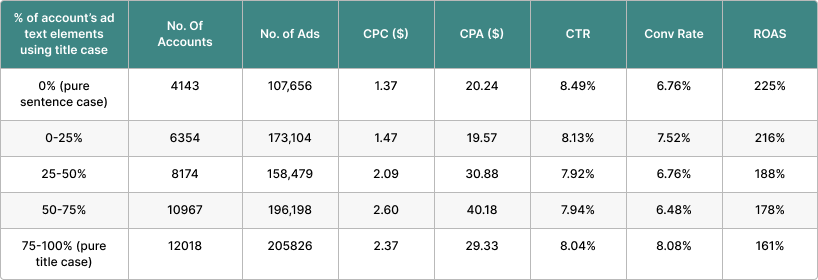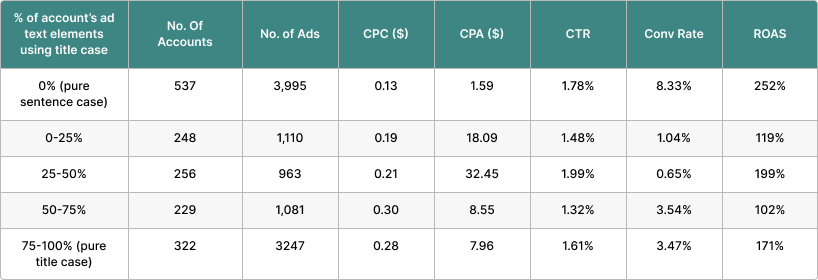Mastering effective ad copy is crucial for achieving success with Google Ads.
Yet, the PPC landscape can make it challenging to discern which optimization techniques truly yield results.
Although various perspectives exist on optimizing ads, few are substantiated by comprehensive data. A recent study from Optmyzr attempted to address this.
The goal isn’t to promote or dissuade any specific method but to provide a clearer understanding of how different creative decisions impact your campaigns.
Use the data to help you identify higher profit probability opportunities.
Methodology And Data Scope
The Optmyzr study analyzed data from over 22,000 Google Ads accounts that have been active for at least 90 days with a minimum monthly spend of $1,500.
Across more than a million ads, we assessed Responsive Search Ads (RSAs), Expanded Text Ads (ETAs), and Demand Gen campaigns. Due to API limitations, we could not retrieve asset-level data for Performance Max campaigns.
Additionally, all monetary figures were converted to USD to standardize comparisons.
Key Questions Explored
To provide actionable insights, we focused on addressing the following questions:
- Is there a correlation between Ad Strength and performance?
- How do pinning assets impact ad performance?
- Do ads written in title case or sentence case perform better?
- How does creative length affect ad performance?
- Can ETA strategies effectively translate to RSAs and Demand Gen ads?
As we evaluated the results, it’s important to note that our data set represents advanced marketers.
This means there may be selection bias, and these insights might differ in a broader advertiser pool with varying levels of experience.
The Relationship Between Ad Strength And Performance
Google explicitly states that Ad Strength is a tool designed to guide ad optimization rather than act as a ranking factor.
Despite this, marketers often hold mixed opinions about its usefulness, as its role in ad performance appears inconsistent.
 Image from author, September 2024
Image from author, September 2024Our data corroborates this skepticism. Ads labeled with an “average” Ad Strength score outperformed those with “good” or “excellent” scores in key metrics like CPA, conversion rate, and ROAS.
This disparity is particularly evident in RSAs, where the ROAS tends to decrease sharply when moving from “average” to “good,” with only a marginal increase when advancing to “excellent.”
 Screenshot from author, September 2024
Screenshot from author, September 2024Interestingly, Demand Gen ads also showed a stronger performance with an “average” Ad Strength, except for ROAS.
The metrics for conversion rates in Demand Gen and RSAs were notably similar, which is surprising since Demand Gen ads are typically designed for awareness, while RSAs focus on driving transactions.
Key Takeaways:
- Ad Strength doesn’t reliably correlate with performance, so it shouldn’t be a primary metric for assessing your ads.
- Most ads with “poor” or “average” Ad Strength labels perform well by standard advertising KPIs.
- “Good” or “excellent” Ad Strength labels do not guarantee better performance.
How Does Pinning Affect Ad Performance?
Pinning refers to locking specific assets like headlines or descriptions in fixed positions within the ad. This technique became common with RSAs, but there’s ongoing debate about its efficacy.
Some advertisers advocate for pinning all assets to replicate the control offered by ETAs, while others prefer to let Google optimize placements automatically.
 Image from author, September 2024
Image from author, September 2024Our data suggests that pinning some, but not all, assets offers the most balanced results in terms of CPA, ROAS, and CPC. However, ads where all assets are pinned achieve the highest relevance in terms of CTR.
Still, this marginally higher CTR doesn’t necessarily translate into better conversion metrics. Ads with unpinned or partially pinned assets generally perform better in terms of conversion rates and cost-based metrics.
Key Takeaways:
- Selective pinning is optimal, offering a good balance between creative control and automation.
- Fully pinned ads may increase CTR but tend to underperform in metrics like CPA and ROAS.
- Advertisers should embrace RSAs, as they consistently outperform ETAs – even with fully pinned assets.
Title Case Vs. Sentence Case: Which Performs Better?
The choice between title case (“This Is a Title Case Sentence”) and sentence case (“This is a sentence case sentence”) is often a point of contention among advertisers.
Our analysis revealed a clear trend: Ads using sentence case generally outperformed those in title case, particularly in RSAs and Demand Gen campaigns.
 Image from author, September 2024
Image from author, September 2024(RSA Data)
 Image from author, September 2024
Image from author, September 2024(ETA Data)
 Image from author, September 2024
Image from author, September 2024(Demand Gen)
ROAS, in particular, showed a marked preference for sentence case across these ad types, suggesting that a more natural, conversational tone may resonate better with users.
Interestingly, many advertisers still use a mix of title and sentence case within the same account, which counters the traditional approach of maintaining consistency throughout the ad copy.
Key Takeaways:
- Sentence case outperforms title case in RSAs and Demand Gen ads on most KPIs.
- Including sentence case ads in your testing can improve performance, as it aligns more closely with organic results, which users perceive as higher quality.
- Although ETAs perform slightly better with title case, sentence case is increasingly the preferred choice in modern ad formats.
The Impact Of Ad Length On Performance
Ad copy, particularly for Google Ads, requires brevity without sacrificing impact.
We analyzed the effects of character count on ad performance, grouping ads by the length of headlines and descriptions.
 Image from author, September 2024
Image from author, September 2024 Image from author, September 2024
Image from author, September 2024(RSA Data)
 Image from author, September 2024
Image from author, September 2024 Image from author, September 2024
Image from author, September 2024(ETA Data)
 Image from author, September 2024
Image from author, September 2024 Image from author, September 2024
Image from author, September 2024(Demand Gen Data)
Interestingly, shorter headlines tend to outperform longer ones in CTR and conversion rates, while descriptions benefit from moderate length.
Ads that tried to maximize character counts by using dynamic keyword insertion (DKI) or customizers often saw no significant performance improvement.
Moreover, applying ETA strategies to RSAs proved largely ineffective.
In almost all cases, advertisers who carried over ETA tactics to RSAs saw a decline in performance, likely because of how Google dynamically assembles ad components for display.
Key Takeaways:
- Shorter headlines lead to better performance, especially in RSAs.
- Focus on concise, impactful messaging instead of trying to fill every available character.
- ETA tactics do not translate well to RSAs, and attempting to replicate them can hurt performance.
Final Thoughts On Ad Optimizations
In summary, several key insights emerge from this analysis.
First, Ad Strength should not be your primary focus when assessing performance. Instead, concentrate on creating relevant, engaging ad copy tailored to your target audience.
Additionally, pinning assets should be a strategic, creative decision rather than a hard rule, and advertisers should incorporate sentence case into their testing for RSAs and Demand Gen ads.
Finally, focus on quality over quantity in ad copy length, as longer ads do not always equate to better results.
By refining these elements of your ads, you can drive better ROI and adapt to the evolving landscape of Google Ads.
Read the full Ad Strength & Creative Study from Optmyzr.
More resources:
Featured Image: Sammby/Shutterstock
 seolounge
seolounge